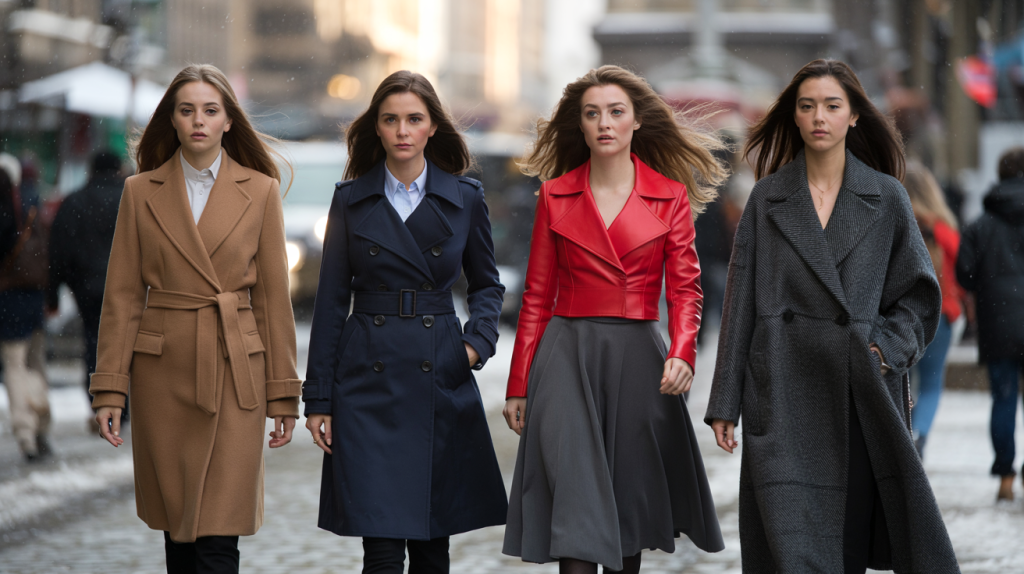Every coat looks perfect on the hanger then strange in the mirror. That mismatch rarely comes from the mirror. It comes from proportions, structure and where a coat lands on the body.
Here is the fast answer. Match coat length to leg length, place shaping at your natural waist or shoulder line, and use lapels and closures to draw the eye where you want it. This simple morphology lens turns a tricky purchase into a precise one, without sacrificing warmth or style.
How to choose a women’s coat by body shape: the quick fix
The idea is simple. Create balance. Length controls vertical lines, lapels and closures guide the gaze, belts mark the waist, shoulders set the frame. Start there, not with the color or trend.
Hem matters. The average woman in the United States stands about 5 ft 4 in, roughly 162 cm (CDC, National Center for Health Statistics, 2015–2018). On that height, a coat that ends around mid‑thigh elongates the leg. A midi that cuts at the widest part of the calf tends to compress the silhouette. Aim for just above or just below that widest point to keep the line clean.
Warmth is not guesswork either. Down fill power between 600 and 900 signals loft and insulation. Higher numbers trap more air for the weight (REI Co‑op, Expert Advice: Down Insulation). For wool, a dense weave and a touch of cashmere increase warmth without bulk.
Morphology 101: identify your body type, then balance proportions
Spot the line that is naturally widest, then either echo it with structure or shift focus elsewhere. That is the whole trick.
- Rectangle shape : add shape with belted wrap coats, princess seams and softly padded shoulders.
- Hourglass shape : follow the curve with tailored peacoats or trench coats that cinch at the true waist.
- Pear shape : broaden the top with sharp lapels, structured shoulders, cropped jackets over A‑line midis.
- Inverted triangle : soften the top with shawl collars, keep lapels narrow, add volume below with flared hems.
- Apple shape : create a vertical line with single‑breasted styles, gentle waist definition, clean fronts without bulky pockets at the tummy.
Button stance changes everything. A higher top button lifts the eye and shortens the torso visually. A lower stance lengthens the torso and can slim the midsection. Try both in front of a mirror and watch the proportion shift in seconds.
Common fit mistakes when buying a coat online
People often size up for layering and end up drowning in fabric. Instead, measure the shoulder seam on a blazer that fits and match that width in the size chart. If the shoulders are right, alterations elsewhere stay minimal.
Pocket placement trips many carts. Patch pockets at the hip add visual width. Side‑entry pockets cut on the seam keep the silhouette sleek. The same goes for quilting. Large square baffles add volume. Narrow vertical channels look leaner.
Mind the hem against height. A midi that works on a 175 cm frame can hit the wrong point on a 160 cm frame. That is where returns pile up and waste rises. One garbage truck of textiles is landfilled or burned every second worldwide, driven in part by short use and returns (Ellen MacArthur Foundation, 2017). Choosing a coat that fits the first time reduces that footprint.
Lining signals quality. A viscose or cupro lining breathes better than polyester in city commuting. Sleeves lined in slippery fabric help knitwear slide in without twisting the armhole. Small detail, big comfort.
Fabrics, warmth and details: make the pick that lasts
Wool blends between 70 and 80 percent wool balance warmth, drape and price. Pure cashmere feels luxe but can bag at elbows if the knit is loose. For rain, a bonded cotton trench handles showers, while a 2 or 3 layer membrane shell manages downpours without the bulk of padding.
Hardware matters in winter. Two‑way zippers let the hem open for walking while keeping the torso closed. Hidden snaps keep lines clean on minimal coats. A throat latch or storm flap on a trench actually blocks wind at the collar on a bike ride.
Color works like tailoring. Dark neutrals recede, bright lapels or scarves bring light near the face. If skin tone reads cool, charcoal and navy usually flatter. Warm complexions often glow next to camel and olive. Test in daylight, not bathroom lighting.
Final check before buying. Stand straight, lift arms, hug yourself. The shoulder should not bite, the sleeve should cover the wrist bone, the belt should sit at the narrowest point you can feel with your hands. If those three pass, the coat will live hard and look sharp. That is the missing step many skipped and definitly regret later.
One last note on durability and warmth per weight: down with 700+ fill power insulates impressively for its mass, yet wet conditions call for synthetic or treated fills that retain loft when damp (REI Co‑op, Expert Advice). Better fit means longer wear, fewer returns and less waste in a system where textile recycling remains low relative to volumes sent to landfill (U.S. EPA, Facts and Figures about Materials, Waste and Recycling).
